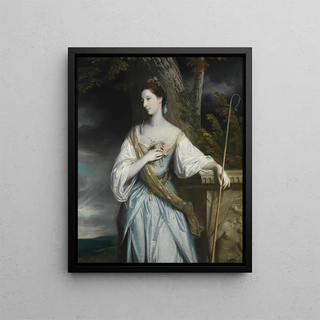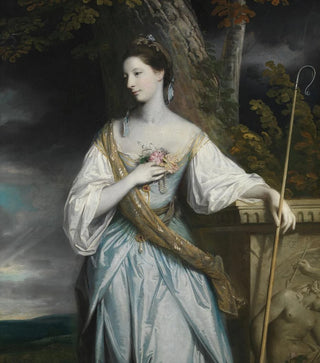Art print | Anne Dashwood 1743-1830, later Countess of Galloway - Sir Joshua Reynolds


View from behind

Frame (optional)
Anne Dashwood 1743-1830, later Countess of Galloway - Sir Joshua Reynolds – Captivating introduction
The artwork "Anne Dashwood 1743-1830, later Countess of Galloway" by Sir Joshua Reynolds embodies the refinement and sophistication of 18th-century British aristocracy. This portrait, depicting a woman of striking beauty, is much more than a simple representation; it is a window into an era where art and nobility were deeply intertwined. By admiring this piece, the viewer is transported into a universe where every detail, every brushstroke, tells a story of elegance and power. The soft light caressing the countess's face, along with the delicate drapery of her gown, evoke an atmosphere of serenity and dignity, inviting prolonged contemplation.
Style and uniqueness of the artwork
Reynolds's style is characterized by an exceptional mastery of light and color, as well as meticulous attention to detail. In this portrait, the sfumato technique is particularly highlighted, creating subtle transitions between shadows and highlights. The nuances of flesh, delicately rendered, bring to life an expression imbued with grace and nobility. The composition is carefully balanced, with a blurred background that emphasizes the main subject. This artistic choice allows focus on the face and posture of the countess, while suggesting a refined environment without ever overwhelming it. The richness of textures, whether in fabrics or hair, demonstrates unparalleled craftsmanship and aesthetic sensitivity, making this artwork a true masterpiece.
The artist and his influence
Sir Joshua Reynolds, one of the most influential painters of his time, captured the very essence of British society through his portraits. As the first president of the Royal Academy, he not only shaped the artistic landscape of his era but also paved the way for many artists who followed in his footsteps. His innovative approach to portraiture, blending realism and idealism, redefined the standards of pictorial representation. Reynolds drew inspiration from

Matte finish

View from behind

Frame (optional)
Anne Dashwood 1743-1830, later Countess of Galloway - Sir Joshua Reynolds – Captivating introduction
The artwork "Anne Dashwood 1743-1830, later Countess of Galloway" by Sir Joshua Reynolds embodies the refinement and sophistication of 18th-century British aristocracy. This portrait, depicting a woman of striking beauty, is much more than a simple representation; it is a window into an era where art and nobility were deeply intertwined. By admiring this piece, the viewer is transported into a universe where every detail, every brushstroke, tells a story of elegance and power. The soft light caressing the countess's face, along with the delicate drapery of her gown, evoke an atmosphere of serenity and dignity, inviting prolonged contemplation.
Style and uniqueness of the artwork
Reynolds's style is characterized by an exceptional mastery of light and color, as well as meticulous attention to detail. In this portrait, the sfumato technique is particularly highlighted, creating subtle transitions between shadows and highlights. The nuances of flesh, delicately rendered, bring to life an expression imbued with grace and nobility. The composition is carefully balanced, with a blurred background that emphasizes the main subject. This artistic choice allows focus on the face and posture of the countess, while suggesting a refined environment without ever overwhelming it. The richness of textures, whether in fabrics or hair, demonstrates unparalleled craftsmanship and aesthetic sensitivity, making this artwork a true masterpiece.
The artist and his influence
Sir Joshua Reynolds, one of the most influential painters of his time, captured the very essence of British society through his portraits. As the first president of the Royal Academy, he not only shaped the artistic landscape of his era but also paved the way for many artists who followed in his footsteps. His innovative approach to portraiture, blending realism and idealism, redefined the standards of pictorial representation. Reynolds drew inspiration from






